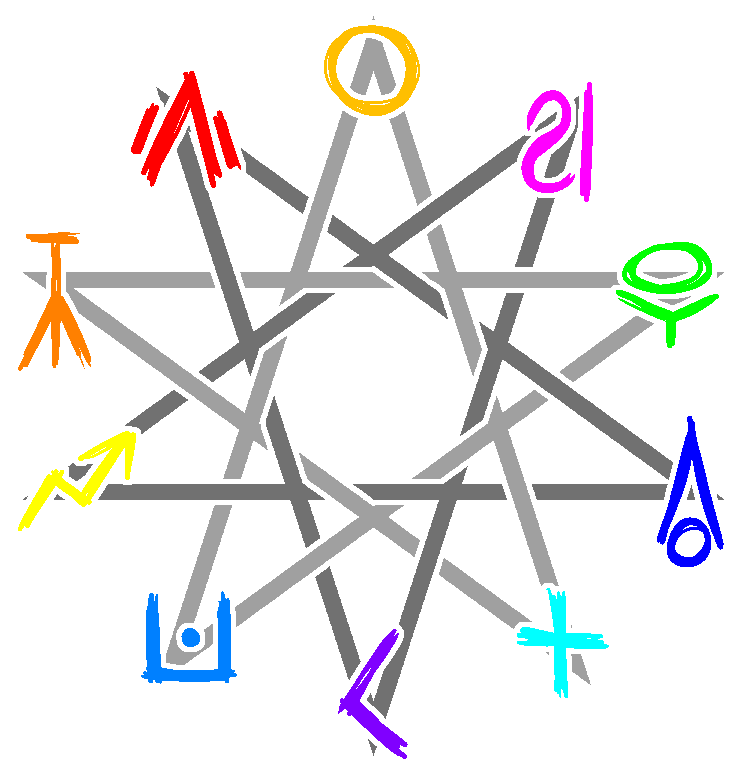The below "double pentagram" is the most common way of illustrating the modern Rixilian understanding of how the elements are intertwined:
 The two pentagrams represent two broad groups the elements fall into: "orderly" and "chaotic."
The two pentagrams represent two broad groups the elements fall into: "orderly" and "chaotic."
The lighter pentagram represents the orderly elements--planetary forces that are concrete and relatively predictable. These elements often represent the solid mass of the planet, such as metallic ores and plant life. The sun is also included as the broad representation of this group, as no life could possibly form without its reliable source of light.
The darker pentagram represents the chaotic elements--planetary forces that actively fluctuate in great degrees. These elements often represent sudden phenomena of the planet, such as wildfires and thunderstorms. The moon is also included as the broad representation of this group, ever-changing with its own phases and pulling the tides.
While these terms may suggest some sort of conflict, it's worth noting that the gods and their elements as a whole represent the balance of the planet--without any one of them, Rixile would quickly become uninhabitable. Even the erratic-seeming elements play a vital role.
Within the two groups, the elements are then assigned one of five categories, based on how they interact within their group. This creates five distinct, opposing pairs:
Orderly The reliable, concrete forces. | Chaotic The transient, mutable forces. | |
Integral Elements that set the planet and all its forces into motion. Considered enigmatic. | Light (Sonata) *Daytime, the sun, magic, artists, justice, etc. A force of brightness and color. | Dark (Nocturne) *Nighttime, the moon, thieves, space, entertainers, etc. A force of shade and depth. |
Directional Elements that signify the coming and going of the seasons. Considered flexible. | Wood (Phyll) *Plant life, the hearth, medicine, farmers, peace, etc. A force of comfort and bonds. | Thunder (Volt) *Electricity, storms, the stars, messengers, navigators, etc. A force of change and exploration. |
Temperamental Elements that drive societies to both their highs and their lows. Considered diligent. | Ice (Cryos) *Snow, the soul, sleep, the afterlife, fate, etc. A force of history and rest. | Fire (Ignus) *Flames, workers, warfare, retribution, the forge, etc. A force of progress and energy. |
Aptitudinal Elements that enrich the lands with diversity and treasures. Considered inventive. | Metal (Galvan) *Machines, time, mathematics, commerce, craftsmen, etc. A force of guidance and invention. | Air (Aether) *Wind, the mind, fortune, mysteries, the sky, etc. A force of spontaneity and secrets. |
Foundational Elements that form the building blocks on which all life relies. Considered genuine. | Earth (Terra) *Stone, animal life, the body, fertility, willpower, etc. A force of balance and physicality. | Water (Mist) *Marine life, love, festivity, the senses, hunters, etc. A force of emotion and spirituality. |
The domains for each element are broad and cannot be comprehensively listed, but the terms above are the common, globally-accepted definitions of each element. Their historical names are retained not only due to the classical association of the gods with primordial planetary forces, but also because their simple names make these complex ideas easier to remember.
The current modern interpretation of the elements is that they stretch so broadly as to include literally everything on the planet, as without the gods and their domains, there wouldn't be anything at all.